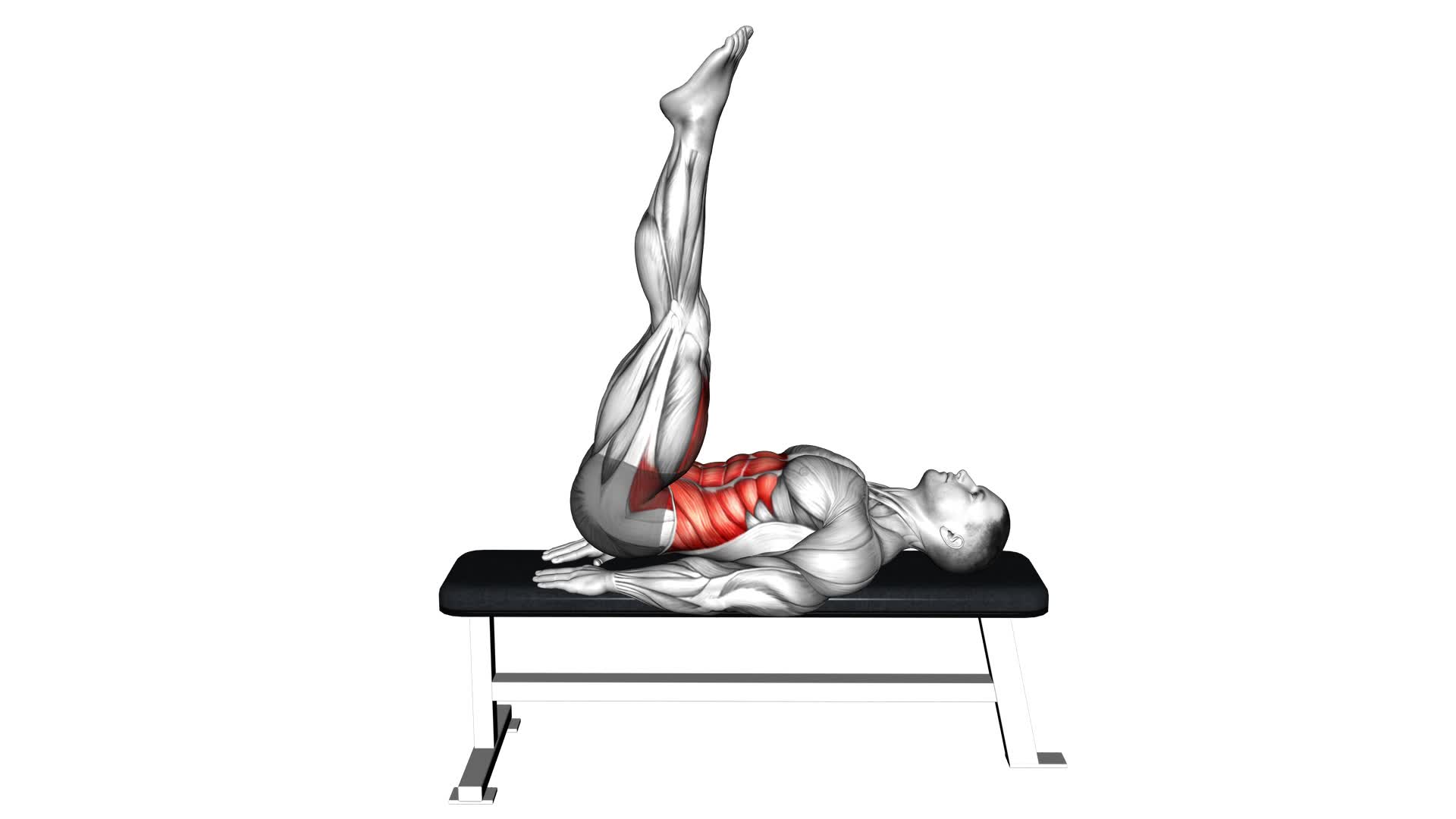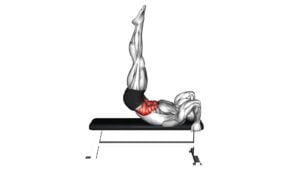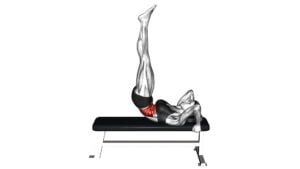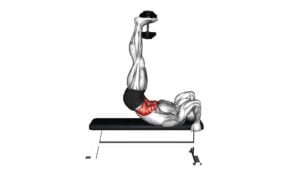Lying Leg Raise Flat Bench – Video Exercise Guide & Tips

Are you looking to strengthen your core and tone your lower body? Look no further than the lying leg raise on a flat bench. This exercise targets your abs, hip flexors, and thighs, helping you achieve a sculpted physique.
Watch This Exercise Video
In this article, we'll guide you through proper form and technique, offer variations to challenge yourself, and provide tips for a more effective workout.
Get ready to take your fitness to the next level with the lying leg raise!
Key Takeaways
- Lying leg raises target lower abdominal muscles, hip flexors, and thigh muscles.
- Proper form and technique are crucial to avoid injury and maximize effectiveness.
- Variation and progression can be achieved by adding ankle weights, using an incline bench, hanging from a pull-up bar, and incorporating side leg raises.
- Breathing techniques and the use of resistance bands can enhance the workout and provide faster results.
Benefits of Lying Leg Raise
You will experience numerous benefits from incorporating lying leg raises into your workout routine. This exercise primarily targets your lower abdominal muscles, hip flexors, and thigh muscles. By engaging these muscles, lying leg raises help you develop a strong and defined lower body.
One of the key benefits of lying leg raises is the increased core strength that it provides. This exercise requires you to stabilize your core throughout the movement, which helps to strengthen your abdominal muscles and improve your overall core stability. A strong core is essential for maintaining proper posture, preventing lower back pain, and improving your athletic performance.
In addition to targeting specific muscles and increasing core strength, lying leg raises also promote overall body balance and stability. By engaging your core and lower body muscles, this exercise helps improve your coordination and balance, making it easier to perform other exercises and daily activities.
Incorporating lying leg raises into your workout routine can also enhance your flexibility. As you raise your legs, you're stretching your hip flexors and increasing the range of motion in your hips, which can benefit your overall flexibility and mobility.
To experience these benefits, aim to incorporate lying leg raises into your workout routine a few times a week. Start with a comfortable number of repetitions and gradually increase as you become stronger and more proficient in the exercise. Remember to maintain proper form and engage your core throughout the movement for optimal results.
Proper Form and Technique
To ensure optimal results and prevent injury, it's important to maintain proper form and technique when performing lying leg raises. This exercise primarily targets the hip flexors, which are responsible for lifting your legs towards your torso. Additionally, it engages the lower abdominals, specifically the rectus abdominis, as well as the obliques.
To perform the lying leg raise with proper form, lie flat on your back on a bench or mat. Place your hands either under your glutes or by your sides for stability. Keep your legs straight and together, and slowly raise them towards the ceiling, using your hip flexors to lift them. Avoid using momentum or swinging your legs to cheat the movement.
For beginners or those with limited core strength, modifying the lying leg raise can be beneficial. Instead of lifting both legs at once, start by lifting one leg at a time while keeping the other leg on the ground for support. This reduces the load on your core muscles and allows you to gradually build strength before progressing to the full exercise.
Remember to breathe throughout the movement and engage your core muscles to maintain stability. By following proper form and technique, you can maximize the effectiveness of lying leg raises while minimizing the risk of injury.
Variations and Progressions
To progress the lying leg raise exercise, you can incorporate variations that challenge your core and hip flexor strength even further.
Advanced techniques can help you take your workout to the next level and continue to see improvements in your fitness journey.
One modification option is to add ankle weights to increase the resistance and make the exercise more challenging. This will require your muscles to work harder and develop greater strength.
Another option is to perform the exercise on an incline bench, which increases the difficulty by placing more emphasis on your lower abs and hip flexors.
You can also try performing the exercise hanging from a pull-up bar, which adds an element of instability and engages your upper body muscles as well.
Additionally, you can incorporate side leg raises into your routine to target your obliques and improve overall core stability.
Remember to always maintain proper form and technique, and listen to your body to avoid injury.
With these advanced techniques and modification options, you can continue to progress and achieve your fitness goals.
Common Mistakes to Avoid
To avoid common mistakes while performing the lying leg raise exercise on a flat bench, it's important to focus on maintaining proper form and technique throughout the movement.
One common mistake to avoid is using momentum to lift your legs instead of relying on your abdominal muscles. This often happens when you swing your legs upward or lower them quickly without control. To prevent this, engage your core and consciously lift your legs using your abdominal muscles.
Another common mistake is arching your back or lifting your hips off the bench. This not only reduces the effectiveness of the exercise but also puts strain on your lower back. To maintain proper technique, keep your back flat against the bench and your hips grounded throughout the movement.
Lastly, avoid letting your legs drop too low during the lowering phase of the exercise. This can strain your hip flexors and lower back. Instead, lower your legs with control until they're just above the bench, maintaining tension in your abdominal muscles.
Tips for a More Effective Workout
For a more effective workout, try incorporating these tips into your routine.
First, pay attention to your breathing techniques during exercise. Proper breathing can enhance your performance and help you get the most out of your workout. Remember to inhale deeply through your nose and exhale fully through your mouth. This will provide your muscles with the oxygen they need and help you maintain control and stability throughout each movement.
Another tip to consider is incorporating resistance bands for added intensity. Resistance bands are a versatile and affordable tool that can take your workout to the next level. They provide constant tension on your muscles, making them work harder and increasing the effectiveness of your exercises. You can easily incorporate resistance bands into exercises like the lying leg raise on a flat bench. Simply attach the band to your ankles and perform the exercise as usual. The added resistance will challenge your muscles and help you achieve faster results.
Frequently Asked Questions
How Many Sets and Reps Should I Do for the Lying Leg Raise Exercise?
To get the most out of your lying leg raise exercise, it's important to find the right balance between sets and reps. The number of sets and reps you should do depends on your fitness level and goals.
Workout variations can include different leg positions or adding weights for added resistance.
Lying leg raises have many benefits, such as targeting your lower abs and hip flexors, improving core strength, and enhancing stability.
Can I Do the Lying Leg Raise Exercise if I Have Lower Back Pain?
If you have lower back pain, you may need to modify the lying leg raise exercise. It's important to listen to your body and avoid any movements that aggravate your pain.
Instead, consider alternative exercises that can strengthen your core without putting strain on your lower back.
Consult with a fitness professional or physical therapist for personalized recommendations based on your specific condition.
Is It Necessary to Use a Flat Bench for the Lying Leg Raise, or Can I Do It on the Floor?
You don't necessarily have to use a flat bench for the lying leg raise exercise. There are alternative options like doing it on the floor.
However, using a flat bench can offer some benefits. It can provide stability and support for your back, making the exercise more comfortable and effective.
Additionally, using a bench allows you to have a greater range of motion and target your abdominal muscles more effectively.
Can I Add Weights to the Lying Leg Raise Exercise to Make It More Challenging?
Yes, you can definitely add weights to the lying leg raise exercise to make it more challenging.
By incorporating weights, such as ankle weights or dumbbells, you increase the resistance and engage your muscles even more.
This helps to further strengthen your core and leg muscles.
However, it's important to start with lighter weights and gradually increase the load as you become more comfortable and stronger.
Additionally, there are alternative variations of the exercise that you can explore to add variety to your workout routine.
How Long Should I Rest Between Sets of Lying Leg Raises?
To maximize the effectiveness of your lying leg raises, it's important to give your muscles enough rest between sets. The optimal rest period for this exercise is typically around 60-90 seconds. This allows your muscles to recover and recharge before the next set.
However, keep in mind that rest periods can vary depending on your fitness level and goals.
Additionally, you can make the exercise more challenging by incorporating variations such as adding weights or increasing the range of motion.
Conclusion
In conclusion, the lying leg raise on a flat bench is a highly effective exercise for targeting and strengthening the lower abdominal muscles.
By maintaining proper form and technique, you can maximize the benefits of this exercise.
It's important to progress gradually and avoid common mistakes to prevent injury.
Following these tips will ensure a more effective workout and help you achieve your fitness goals.

Author
Years ago, the spark of my life’s passion ignited in my mind the moment I stepped into the local gym for the first time. The inaugural bead of perspiration, the initial endeavor, the very first surge of endorphins, and a sense of pride that washed over me post-workout marked the beginning of my deep-seated interest in strength sports, fitness, and sports nutrition. This very curiosity blossomed rapidly into a profound fascination, propelling me to earn a Master’s degree in Physical Education from the Academy of Physical Education in Krakow, followed by a Sports Manager diploma from the Jagiellonian University. My journey of growth led me to gain more specialized qualifications, such as being a certified personal trainer with a focus on sports dietetics, a lifeguard, and an instructor for wellness and corrective gymnastics. Theoretical knowledge paired seamlessly with practical experience, reinforcing my belief that the transformation of individuals under my guidance was also a reflection of my personal growth. This belief holds true even today. Each day, I strive to push the boundaries and explore new realms. These realms gently elevate me to greater heights. The unique combination of passion for my field and the continuous quest for growth fuels my drive to break new ground.







